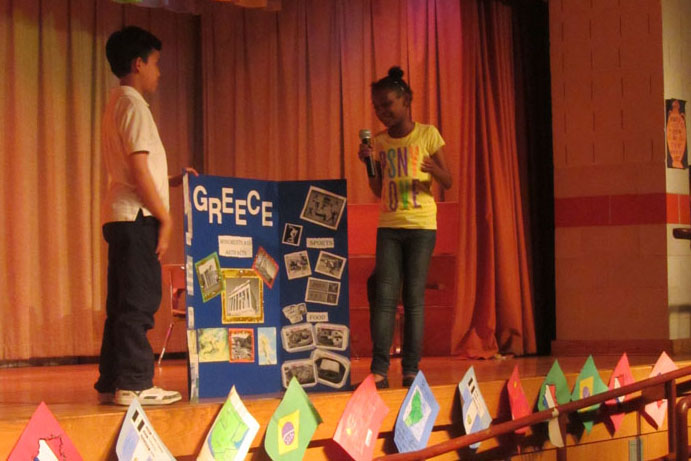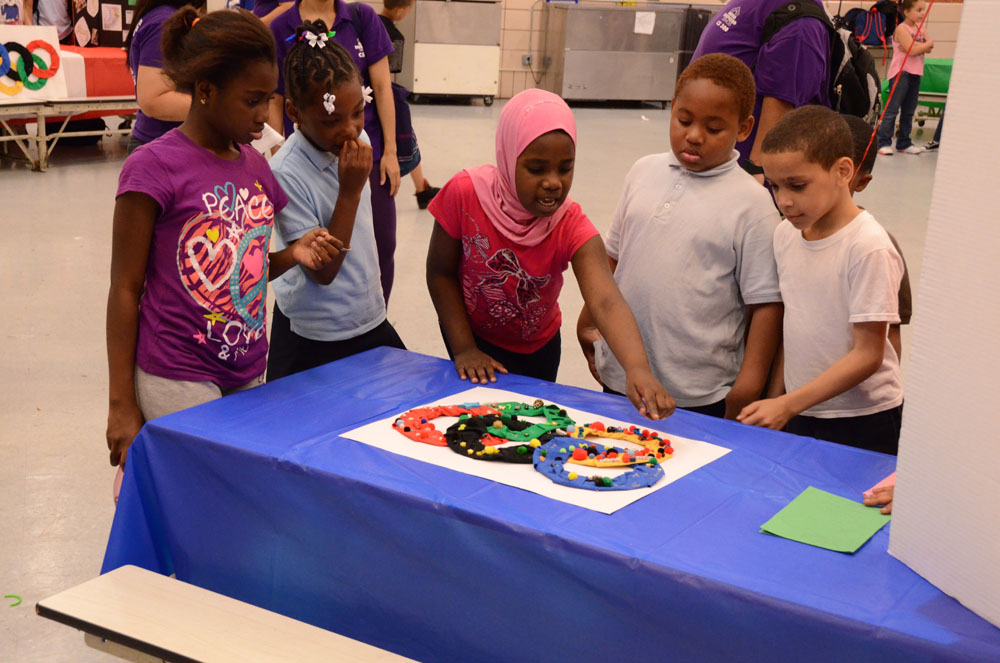 As schools come to a close this week, New York City after school sites, CAMBA at PS 269, Good Shepherd Services at C.S. 300 and Queens Community House at PS 82 instituted a World Olympics curriculum event to teach respect for differences and prepare students for a multicultural and multi-religious world. These three sites were selected to participate in the World Olympics for All initiative which works with after-school education sites to build the on-going capacity to implement Tanenbaum’s multicultural, Common Core aligned curriculum, World Olympics. The initiative, delivered in collaboration with the Partnership for After School Education (PASE) and funded by the Nissan Foundation, provides educators with the sustainable capacity to teach children respect for diversity while also promoting teamwork skills, literacy, and good sportspersonship.
As schools come to a close this week, New York City after school sites, CAMBA at PS 269, Good Shepherd Services at C.S. 300 and Queens Community House at PS 82 instituted a World Olympics curriculum event to teach respect for differences and prepare students for a multicultural and multi-religious world. These three sites were selected to participate in the World Olympics for All initiative which works with after-school education sites to build the on-going capacity to implement Tanenbaum’s multicultural, Common Core aligned curriculum, World Olympics. The initiative, delivered in collaboration with the Partnership for After School Education (PASE) and funded by the Nissan Foundation, provides educators with the sustainable capacity to teach children respect for diversity while also promoting teamwork skills, literacy, and good sportspersonship.
In particular, the World Olympics for All Initiative is designed to:
- Build/support youth’s curiosity about languages, beliefs and customs;
- Explore global interconnectedness to promote global citizenship;
- Teach the importance of events, like the Special Olympics and Paralympics, that represent all athletes;
- Provide an opportunity to observe how culture is represented in the media;
- Promote open discussion about other cultures and countries through visual, oral and written presentations
- Build opportunities to practice teamwork and support one another through good sportspersonship.
Student Learning
 Prior to the culminating event, students became enthusiastic about the cultural learning that occurred while researching countries they would be representing at the event. At Queens Community House, which serves many English language learners from Bangladesh, Mexico, Ecuador, and Guatemala, some students had challenges expressing themselves and seemed shut out. The World Olympics curriculum enabled them to connect to the topics like teamwork, respect, and learning about different traditions. According to Education Specialist Anjelica Balram, “Because we’re learning about other cultures, these students felt like they had something to contribute and that it’s okay to be different. They were reminded of their own cultures and gained a sense of belonging.”
Prior to the culminating event, students became enthusiastic about the cultural learning that occurred while researching countries they would be representing at the event. At Queens Community House, which serves many English language learners from Bangladesh, Mexico, Ecuador, and Guatemala, some students had challenges expressing themselves and seemed shut out. The World Olympics curriculum enabled them to connect to the topics like teamwork, respect, and learning about different traditions. According to Education Specialist Anjelica Balram, “Because we’re learning about other cultures, these students felt like they had something to contribute and that it’s okay to be different. They were reminded of their own cultures and gained a sense of belonging.”
The Final Olympic Games
 All of the students’ interest shone through at their culminating events. The afternoon of fun and learning began with opening ceremonies where students showed each other their countries’ colors and shared what they learned. Each site put their own unique spin on this segment, some including speeches and chants from student-ambassadors; others greeted each other in their country’s language. At CAMBA, one student ambassador shared that the best thing she learned from studying Hong Kong, was that “even though we are all different, we are all the same.” Students shared many more insights through displays created about their countries, which included student artwork as well as facts.
All of the students’ interest shone through at their culminating events. The afternoon of fun and learning began with opening ceremonies where students showed each other their countries’ colors and shared what they learned. Each site put their own unique spin on this segment, some including speeches and chants from student-ambassadors; others greeted each other in their country’s language. At CAMBA, one student ambassador shared that the best thing she learned from studying Hong Kong, was that “even though we are all different, we are all the same.” Students shared many more insights through displays created about their countries, which included student artwork as well as facts.
Throughout the events, students buzzed with enthusiasm, acknowledging good sportspersonship along the way. Whether playing silly games, like charades, or building paper sculptures of the Eiffel Tower, teamwork and good sportsmanship were in focus. After a long afternoon of fun and learning, the games closed with students acknowledging each other in their hard work.
Curriculum Discount and Next Steps
While the next request for applications (RFA) to become a World Olympics for All intensive site, won’t be announced until next fall, summer youth programs serving K-7 youth can bring the World Olympics to their site this summer. To save 20% when you order your copies of the curriculum type in the code type in WOSummer. Discount expires July 31st, 2014.
To learn more about training your staff in the World Olympics curriculum or with any questions, contact [email protected].